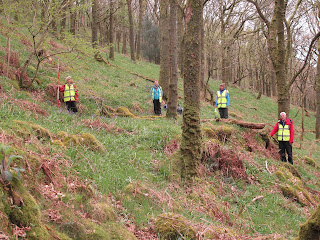We Need You for Season Two
Our second season of woodland survey in the Rusland Horizons Scheme Area is quickly
approaching and we are now recruiting volunteers. The first season, which ran
between April 10th and May 10th 2017, was hugely successful with a total of 216 hectares of woodland surveyed
in full or in part, leaving us with 196 unexplored hectares to be surveyed this
year, which we can’t do without your help.
 |
Volunteers demonstrating the profile of a pitstead that has
been cut into a steep slope
|
The most common features that we found and recorded last year were charcoal
pitsteads; the level earth platforms created for burning circular stacks of wood
during the process of producing charcoal. They were so common in the Rusland
Valley that we recorded 161 of them! ‘Pitstead’ is the term used in Cumbria to
describe the platforms, in other areas they may be referred to as charcoal
hearths or stacks. The pitsteads come in two distinct
types; one is a circular area of cleared woodland, the other is more oval in
shape and they tend to be cut into a slope creating a very visible profile. The
frequency of these pitsteads, particularly the number on steep slopes,
indicates that the charcoal burners were using as much of the woodland as they
could access.
 |
One of the huts found in the woodland. The stone hearth
can be seen between the volunteers.
|
Another indicator of the scale of industry within
the woods was the presence of the huts which would have been used as seasonal
housing for either charcoal burners, bark peelers or possibly both, as these
practices took place at different times of the year. Last year we recorded nine
ruinous examples of these huts, which were originally made from turf or stone.
Although they vary in form all contained a distinct beehive-shaped, stone-constructed
hearth.
 |
Rabbit smoot
|
Many other features were found within the woods, some
quite common such as tracks, relict walls, hollows and rabbit smoots. Rabbit
smoots are small openings found in the base of walls to allow rabbits to pass
through. These serve two functions: the first is to stop rabbits from burrowing
under the walls, which would weaken the structure of the walls; the second is
that a trap was often set on one side of the wall, affording whoever was
working in the woods at the time an easy supper. More unusual features
recorded included a distinct ‘Hek’ gatepost, a circular stone hunting hide and
a commemorative date stone from 1926.
Overall, we had a fantastic season of surveying last year, during which
we got extremely lucky with the weather and recorded a total of 272
archaeological features. If you fancy joining us for what promises to be a very
exciting second season, please go to http://www.ruslandhorizons.org/whats-on/2018/january/25/spring-woodland-archaeology-surveys-2018.aspx for further details. No previous experience is necessary. If you want to hear
more about what we found last year and what we will be up to this year, we are holding
an open evening on 28th February. For more details go to http://www.ruslandhorizons.org/whats-on/2018/january/25/rusland-horizons-woodland-survey-archaeology-evening.aspx.
We look forward to seeing you soon!

Comments
Post a Comment